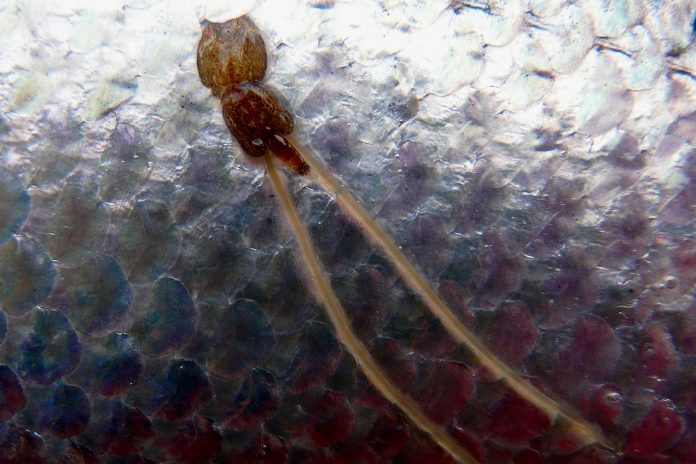They occur naturally in the wild, regardless of farming. But what makes the pests thrive in one particular site, while seemingly low in others? And what can salmon farmers do about it?
SalmonBusiness talked to Dr Tom Adams, who will be supervising a new PHD into the modelling and forecasting of salmon parasites at the Scottish Association for Marine Science (SAMS).
The industry have been transparent since May when it started to voluntarily publish a monthly report on sea lice numbers on the SSPO’s (Scottish Salmon Producers’ Organisation) site. In June and July, some farms experienced higher lice numbers than their other sites.

Numbers
For example in June, despite having the Scottish Salmon Company having a low rate of lice across its sites, Vuia stood out with a sea lice count of 4.69.
When asked about the number, a spokesperson for The Scottish Salmon Company said: “Fish health and welfare is fundamental to responsible salmon farming and intrinsic to our operations. Sea lice are endemic in the wild and the extraordinary warmer water temperature this summer increased the sea lice challenge. We are fully committed to responsible farming practices and stringent health management of our stock.”

SalmonBusiness approached Grieg Shetland, who also experienced higher levels of lice numbers on one site in July: 3.37 at Snizort East. The company did not respond to our requests.
But it’s not about singling out any farm, lice is an accepted industry-wide issue. But if most sites are lower than average, what makes one site more prone to lice?
SAMS
Dr Tom Adams is heading a new PhD project at SAMS to investigate sea lice populations off the west coast of Scotland to help forecast their movement and abundance. An ecological modeller and mathematician with a primary focus on management issues, he said that lice was a unique issue that was in the public interest.

“There’s a range of factors so the water varies in temperature and salinity from place to place. In some places you have water column stratification where it may be very fresh near surface and more saline deep down. In other places or different times of the year, the water would be more mixed and salty through the whole depths of the water,” he said.
Dr Adams explained that lice experience elevated mortality rates in fresh water, hence why it’s starting to be used as a treatment to remove the lice from fish.
Fresh water
“How fresh the water is at a particular farm could affect how prone it would be to being infested by lice. Within Scottish conditions, the temperature wouldn’t really be a factor (for mortality) but the individual growth rates of the organism changes and as temperature increases. This means they will go through their life stages more quickly,” he explained. “Meaning that potential outbreaks can happen more quickly in warmer conditions.”
So if you had a particularly warm summer and also lower rain fall, then that may help to create conditions where lice populations could thrive?
“I suppose if they’re able to remain around a site due to a lack of water movement and that went unchecked then it could allow them to increase more quickly,” added Dr Tom Adams.
But if it’s an outlier, then why?
Why are numbers so different? Is it geographical and/or down to temperatures? We put the question to Prof Geoff Boxshall, whole organism biologist in the LS Invertebrates Division of the Natural History Museum.
“It could be anyone of those reasons. The timing of the treatment for example. Certain locations have more freshwater in the mix. If there is little environmental difference, one would assume at different stages it’s more like to do with the particular time of/and treatment. But if it’s an outlier, then why?” he said.

Looking ahead the new PhD project at SAMS, which is in collaboration with Marine Harvest Scotland and Marine Scotland Science, will investigate sea lice populations on fish farm sites on the west coast of Scotland, and approaches to forecasting their abundance.
Fine resolution data
“We are starting to work with fine resolution data on a weekly basis, which is more detailed than what the industry is publishing at the moment and it’s really in part motivated to understand whether there are non-chemical ways to managing sea lice. Whether you can look at where individual farms are in the environment and understand what that means for the lice population,” he said.
Dr Adams is also to developing a tool which would mean that salmon farmers are able to forecast lice outbreaks forecast which would allow operators to take action.
“The duration of the PHD is three years so we would be looking to see developments within the end of 2020,” Dr Adams said. “All these things take time but we are gradually getting there.”

